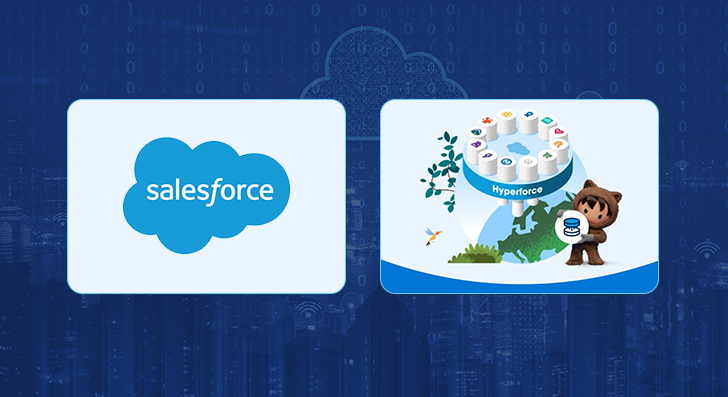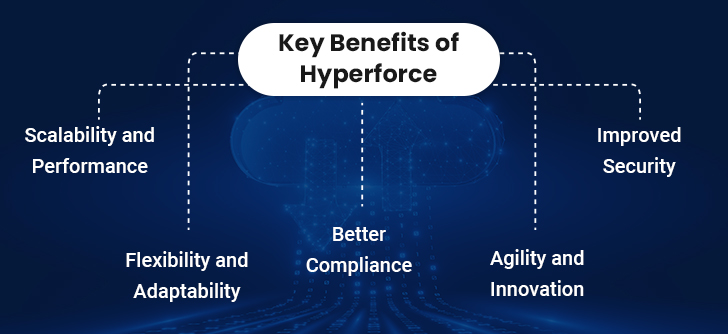Companies today are constantly on the lookout for an edge in operational efficiency and scalability. Salesforce Hyperforce is a next-generation cloud architecture that redefines how businesses operate their data and applications. Hyperforce was built for the public cloud, making it the right choice for companies with expansion and innovation at the forefront of their priorities, offering unmatched security, scalability, and compliance.
With a breakdown of Hyperforce’s advantages, useful implementation techniques, and advice for overcoming obstacles, this guide delves deeply into how mid-level leaders may strategically use it to propel organizational success.

What is Salesforce Hyperforce?
Businesses running Salesforce instances can use public cloud infrastructure since Hyperforce is a cloud-native architecture. Hyperforce permits businesses to operate Salesforce apps on any public cloud infrastructure, a departure from the more traditional Salesforce architecture, which depends on data centers owned by Salesforce. More control over data residence and adherence to regional laws are therefore made possible.
Key Benefits of Hyperforce

- Scalability and Performance: Organizations can easily expand their operations using Hyperforce, ensuring that they can manage higher user and data loads without sacrificing efficiency.
- Flexibility and Adaptability: Businesses may more readily adjust to evolving regulatory requirements and commercial needs with Hyperforce, which facilitates market expansion.
- Better Compliance: Hyperforce assists companies in adhering to local data protection rules and regulations by enabling local data storage.
- Agility and Innovation: By offering quicker settings for development and testing, Hyperforce promotes innovation and helps businesses launch new products and services faster.
- Improved Security: Hyperforce was created with security in mind, providing least-privileged control, strong encryption, and zero-trust principles to safeguard client information.
Need expert guidance on Salesforce Hyperforce? Contact us today.
Why Hyperforce Matters for Strategic Salesforce Development
As enterprises expand, managing a consistent Salesforce environment across regions becomes increasingly complex. Here’s where Hyperforce stands out:
- Regulatory Compliance: Many enterprises grapple with ever-changing data residency laws. With Hyperforce, you can localize data storage while maintaining a unified Salesforce instance, ensuring compliance with GDPR, HIPAA, and other regional regulations.
- Faster Deployment: Whether launching a new product in APAC or scaling operations in Europe, Hyperforce’s flexibility accelerates time-to-market by enabling deployments closer to your end users.
- Cost Optimization: By leveraging public cloud infrastructure, enterprises can reduce their reliance on costly proprietary data centers, cutting down operational expenses.
- Scalability: Hyperforce ensures your Salesforce setup evolves with your business, accommodating sudden spikes in demand without compromising performance.
Steps to Strategically Leverage Hyperforce for Your Enterprise
Step 1: Assess Readiness for Migration
Before transitioning to Hyperforce, conduct a thorough audit of your existing Salesforce environment. Identify legacy customizations that may require reconfiguration, third-party integrations that might need compatibility updates, and data residency requirements in your operating regions.
Step 2: Define Business Objectives
Anchor your Hyperforce migration to specific business goals. For example, improve compliance in emerging markets by deploying Salesforce applications in country-specific cloud regions.
Step 3: Partner with Experts
Hyperforce migration is a complex endeavor. Engage certified Salesforce consultants or internal architects with experience in multi-cloud infrastructure management, data migration best practices, and compliance auditing.
Step 4: Prioritize Security
Leverage Hyperforce’s built-in security features such as advanced encryption and identity access management. Conduct penetration testing post-migration to ensure all endpoints are secure.
Step 5: Test in Stages
Avoid migrating your entire Salesforce instance in one go. Instead, start with non-critical environments or specific regions, monitor performance metrics and user feedback, and gradually scale to other parts of the business.
Step 6: Develop an End-User Strategy
Involve end-users early in the migration process. Provide clear documentation, create training programs, and ensure user-centric customizations to encourage adoption.
Typical Barriers and How to Get Past Them
I) Opposition to Change
Early in the process, involve stakeholders. Organize workshops to explain Hyperforce’s advantages and give important users practical training.
II) Integration Issues
Perform a pre-migration compatibility check for all third-party apps and customizations. Invest in API optimization where necessary.
III) Cost Overruns
Develop a detailed migration roadmap with clear timelines and milestones. Regularly review budget vs. actual costs.
IV) Compliance Complexity
Use Hyperforce’s region-specific hosting to meet data residency requirements and regularly audit compliance practices
V) Downtime Risks
Mitigate potential disruptions by conducting extensive testing and maintaining rollback options for critical systems.
Best Practices for Mid-Level Leaders
1. Align IT Strategy with Business Goals
Ensure Hyperforce implementation directly supports revenue growth, customer satisfaction, and operational efficiency.
2. Communicate with Transparency
Keep teams informed about migration timelines, benefits, and potential disruptions. Transparency builds trust and minimizes resistance.
3. Build a Governance Framework
Establish clear policies for data handling, access controls, and performance monitoring to maintain consistency across regions.
4. Leverage Analytics
Use Salesforce’s analytics tools to measure the success of your Hyperforce migration. Track KPIs like system uptime, transaction speed, and user adoption rates.
5. Invest in Training
Equip teams with the knowledge to make the most of Hyperforce’s capabilities through ongoing training programs.
6. Monitor Performance Continuously
After implementation, establish continuous monitoring to identify bottlenecks, optimize resource allocation, and ensure the system runs smoothly.
Need a secure and scalable Salesforce solution? Let’s explore how Hyperforce can support your business.
How Hyperforce Enables Innovation
Hyperforce isn’t just about operational efficiency—it’s a catalyst for innovation. Here’s how:
a. AI Integration at Scale
With Hyperforce, enterprises can host AI-powered Salesforce features closer to their user base, improving response times for predictive analytics and machine learning models.
b. Smooth Multi-Cloud Operations
Create a unified environment for data sharing and collaboration by integrating Salesforce with other cloud-based systems.
c. Support for Sustainability Goals
Many public cloud providers prioritize renewable energy and carbon-neutral operations in accordance with business sustainability goals.
d. Fast Prototyping and Testing
Hyperforce enables faster creation of testing environments, allowing businesses to test new tools and processes without affecting live systems.
Expert Assistance for Salesforce Hyperforce Implementation
To fully leverage Salesforce Hyperforce, businesses should consider partnering with Salesforce development partners. These certified experts can assist with custom app development, integration, and migration, ensuring a smooth transition to Hyperforce. Collaborating with specialists gives companies the opportunity to enhance customer satisfaction, increase sales, and streamline operations. Salesforce-certified developers are trained professionals that handle the technicalities of the platform and come up with customized solutions that meet specific business requirements.
Looking Ahead
A cloud infrastructure that is more scalable, safe, and compliant is being made possible by the introduction of Salesforce Hyperforce. By switching to Hyperforce and collaborating with skilled providers of Salesforce development services, companies can open up new avenues for innovation and expansion. With Salesforce Hyperforce, embrace the cloud computing future and grow your company.
Need to optimize your Salesforce deployment? Let us help you streamline the process with Hyperforce





